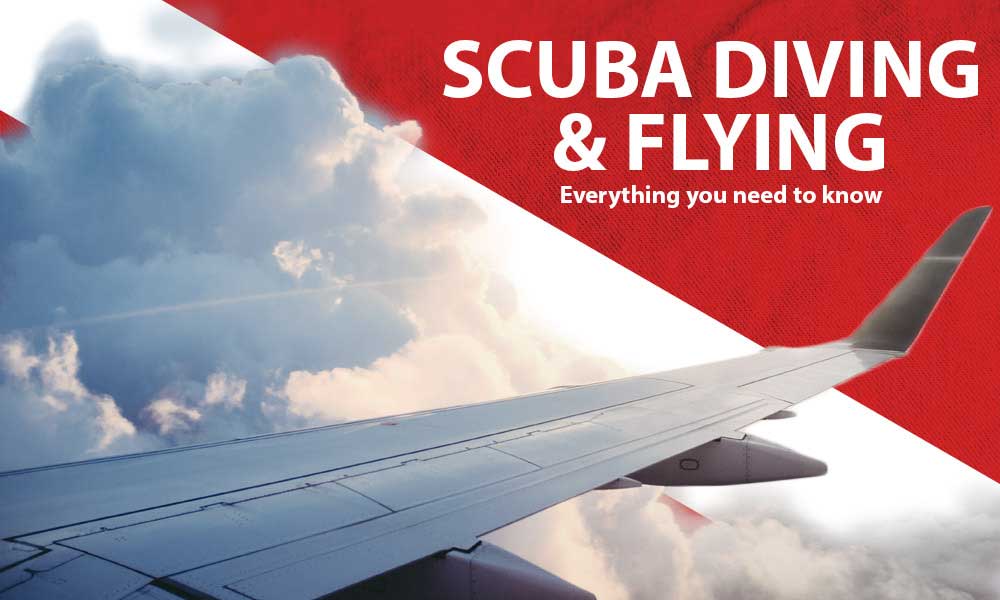
Why Scuba Divers Should Try Freediving: A Personal Perspective from an Scuba diving and Freediving Instructor
Hey everyone, I’m Matt, co-director of OceanSense Freediving here on the Sunny Coast. Over the

Most divers learn that they shouldn’t go flying right after scuba diving when doing their initial training, but few learned any more than that. However, if you plan to fly, especially in charter or personal aircraft after you have recently been diving, there is much more you need to know.
Diving and flying are hobbies that participants many times overlap. The commingling of these activities, when not planned for properly, can be physically dangerous and even fatal.
Whether flying in a personal aircraft or flying on chartered aircraft, there may be more that you need to consider than when you fly home on an airline. While pilots receive some training on the subject, it is pretty minimal and it really should be the diver that knows what to discuss with their pilot to avoid any potential problems if they are going to be flying in their own aircraft.
Nitrogen Cautions
The FAA’s Airman’s Information Manual (AIM) offers a small section entitled “Decompression Sickness After Scuba Diving” that indicates “a pilot or passenger who intends to fly after scuba diving should allow the body sufficient time to rid itself of excess nitrogen absorbed during diving. If not, decompression sickness due to evolved gas can occur during exposure to low altitude and create a serious in-flight emergency.”
It continues, that a pilot (or it is assumed, their passengers) should wait at least 12 hours prior to flying to altitudes up to 8,000’ (MSL) if a dive has not required a “controlled ascent” (non-decompression stop diving) and at least 24 hours after diving in which a “controlled ascent” (decompression requiring) is required. Any flight above 8000’ Mean Sea Level (MSL) (think, the actual altitude above the sea level) should be delayed until at least 24 hours has elapsed. This is as far as the details go on what most pilots learn. But what does that really mean? How long of a wait is really required?
DiveCompare author Mike, notes that, “…the recommendation set out by PADI [the Professional Association of Diving Instructors] is: For single dives, a minimum preflight surface interval of at least 12 hours is recommended. For repetitive dives, or multiple days of diving a minimum preflight surface interval of at least 18 hours is recommended. DAN (Divers Alert Network) recommends 24 hours for repetitive dives, The US Air Force recommends 24 hours after any dive, while the US Navy tables recommend only 2 hours before flying to altitude.”
(https://www.divecompare.com/blog/flying-diving/) The discrepancies in these agency recommendations, and even the FAA AIM, highlights the complexity of the question of how long someone needs to wait to fly after scuba diving.
Of note, the FAA “…recommendations are actual flight altitudes above mean sea level (MSL) and not pressurized cabin altitudes.” This is a critical point because it takes into account concern for any potential loss of pressurization in aircraft that operate in pressurized cabins. While many corporate, chartered, and some personal aircraft do have pressurized cabins, many light aircraft do not. In either case, the diver should assume they will not be in a pressurized cabin, no matter what altitude they will be flying at. Personal, and certainly most cabin class and chartered aircraft, will regularly fly higher than 8000’ MSL altitudes. In non-commercial aircraft, a pilot may even fly up to 12,500’ above the ground in an unpressurized aircraft without any oxygen requirements becoming effective. This added altitude and lesser atmospheric pressure could enhance decompression related effects.
So what are the basics you need to know?
A good practice is to have a “down day” prior to flight after any diving. Space any planned flights (even at lower altitudes) with a day between the last dive and the flight departure. Two days might be a better plan, especially if there was deep or repetitive diving.
Many divers use dive computers that go with them when they dive and if you are going to be flying as a pilot or passenger after diving, these are a critical part of modern safety equipment. The best course of action for any divers that are going to be flying is to use a dive computer for all of their dives. Modern dive computers will calculate a “time-to-fly” and recommend a wait time for a diver prior to a flight.
To be accurate, divers must use the same computer for all their dives, and on every dive. Time-to-fly calculations are cumulative based on diving times, depths, and number of dives. If a diver is using “rental” computers for a dive trip, it is important that they use the same dive computer for all dives (and no other diver uses it) to have accurate time-to-fly calculations.
If you are the pilot who dove or just the pilot who will be flying passengers who were diving, consult the computer prior to flight or after their last dives are completed so you are aware of what wait time is required based on the “time-to-fly” calculation.
There is much more you can learn, more about diving, effects of pressure, symptoms and how different activities affect flight safety. If you want to learn more, I do have expanded information available in another article on my blog. At the very least, knowing that the recommended minimums may not be enough can help you determine if you need to get more information prior to a flight.
Jason Blair is an FAA Pilot Examiner who writes in the aviation industry but is also an active certified Master and Trimix diver who dives most frequently in the Great Lakes.
Article originally from TDISDI – https://www.tdisdi.com/scuba-diving-and-flying/

Hey everyone, I’m Matt, co-director of OceanSense Freediving here on the Sunny Coast. Over the
Join us Thursday 30th Jan at 5:30pm to hear David Mullins talk about nudibranch defences
Dear members, I would like to take this opportunity to inform you about a few